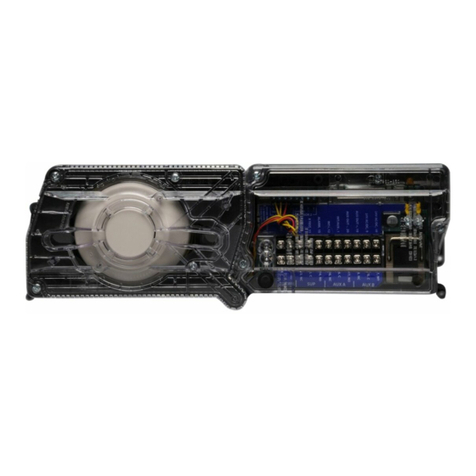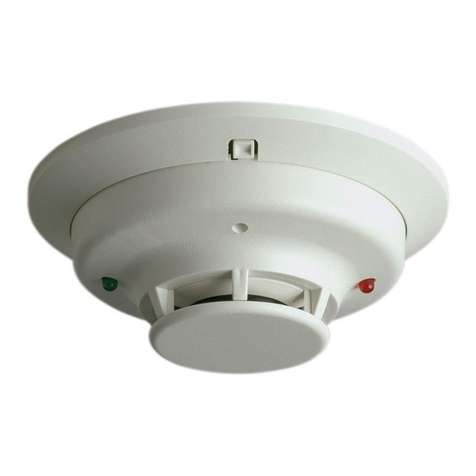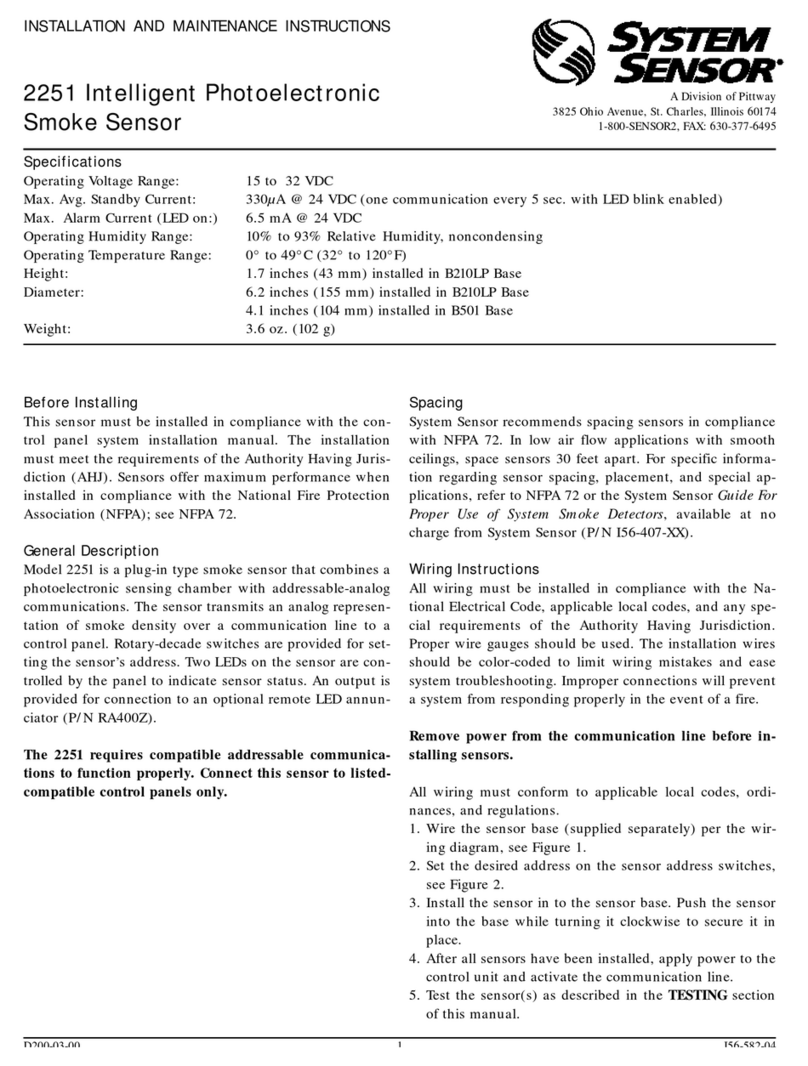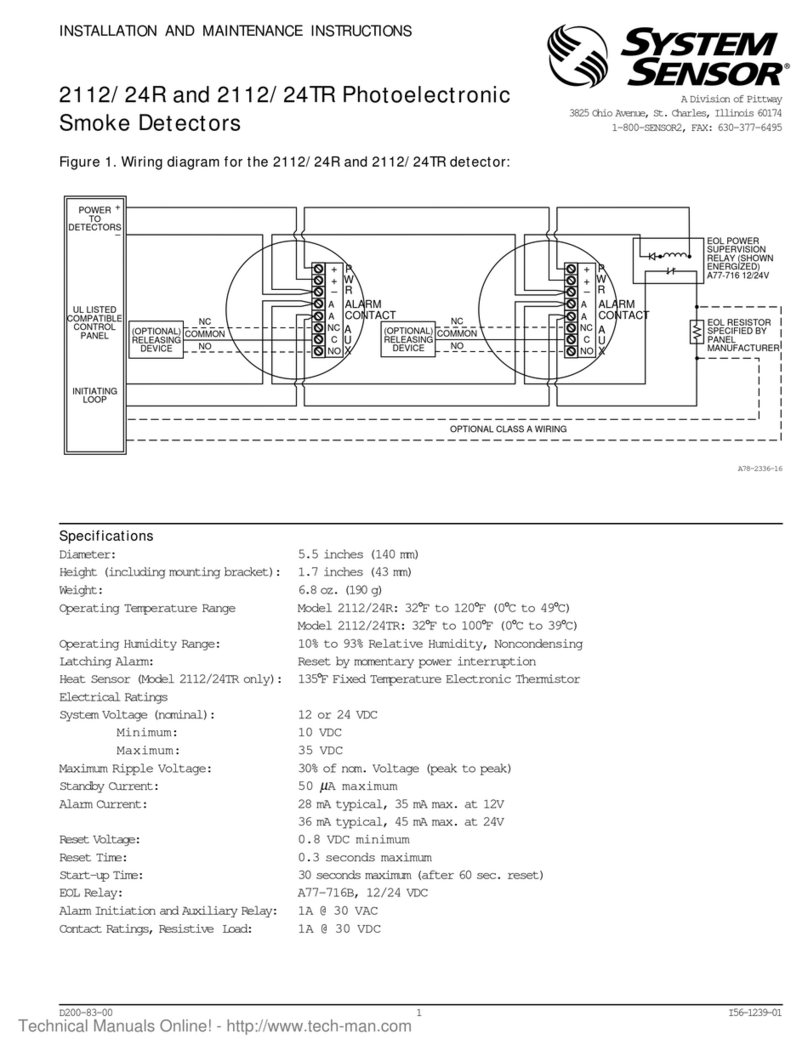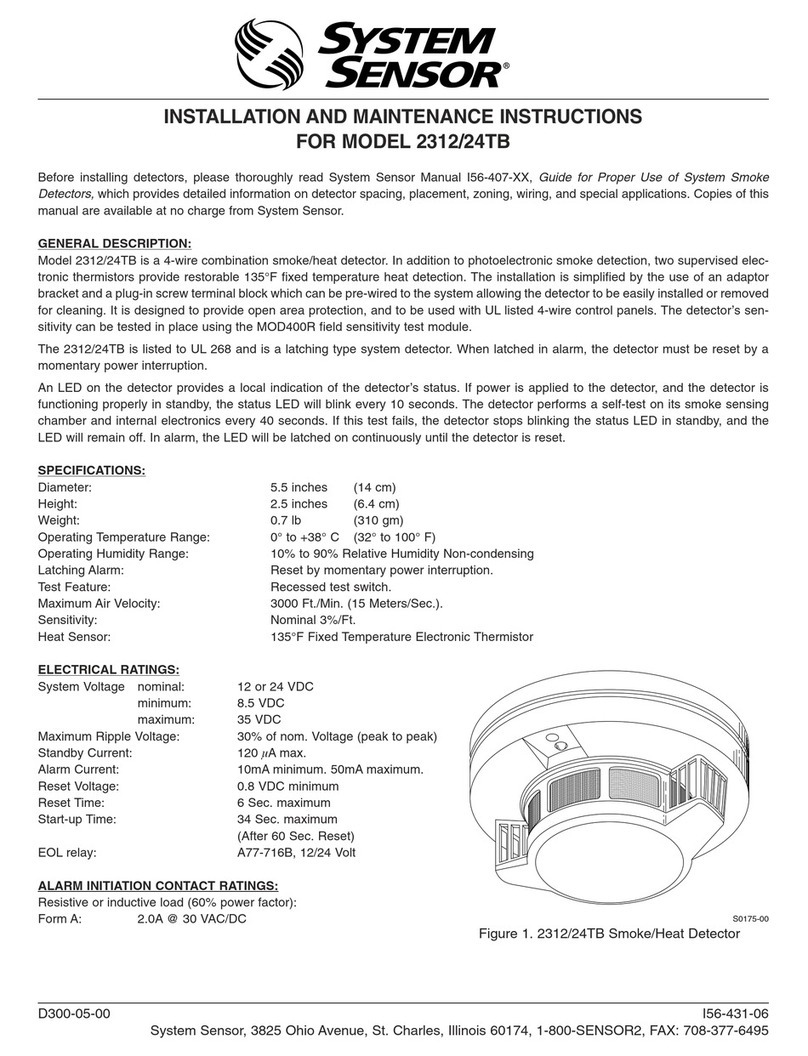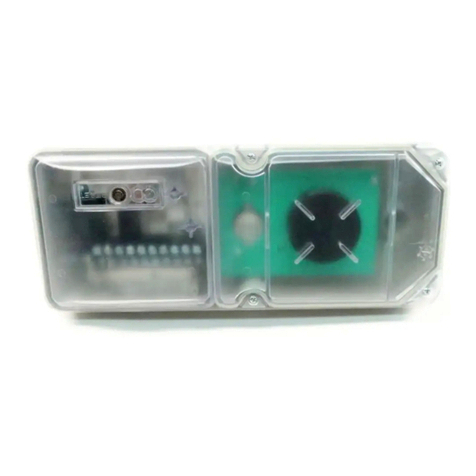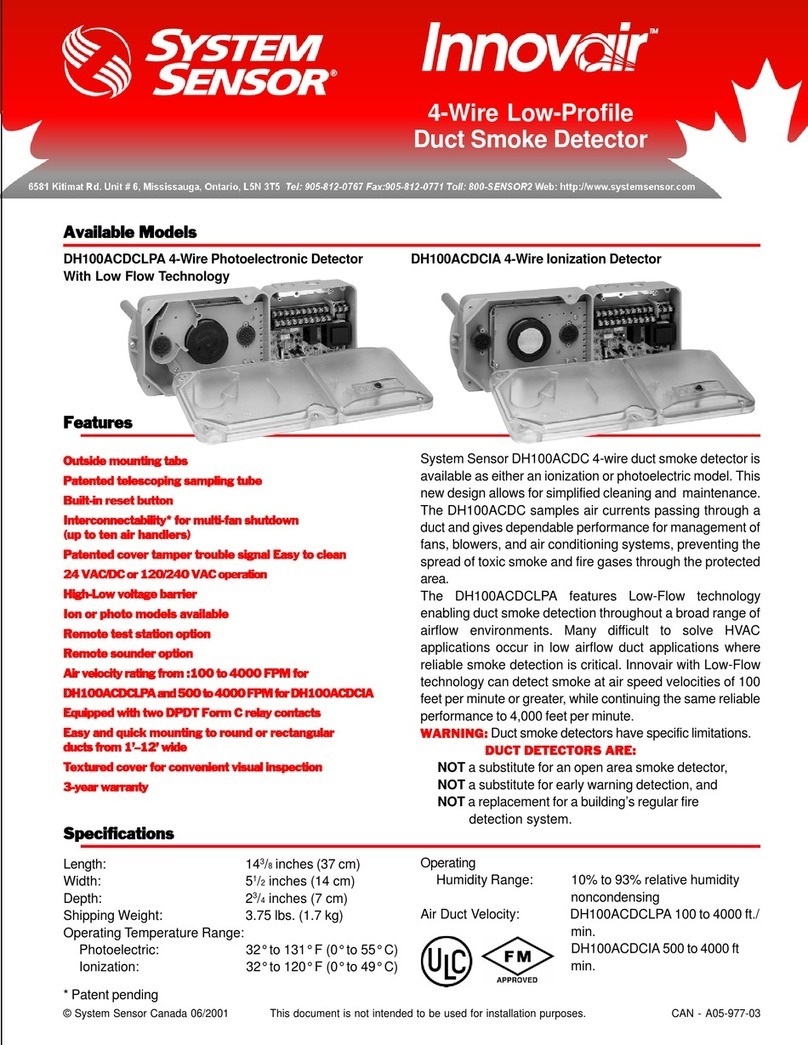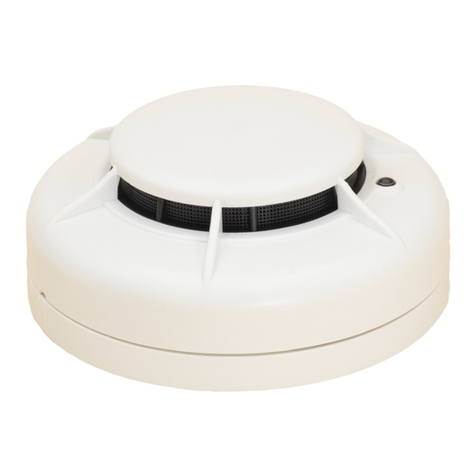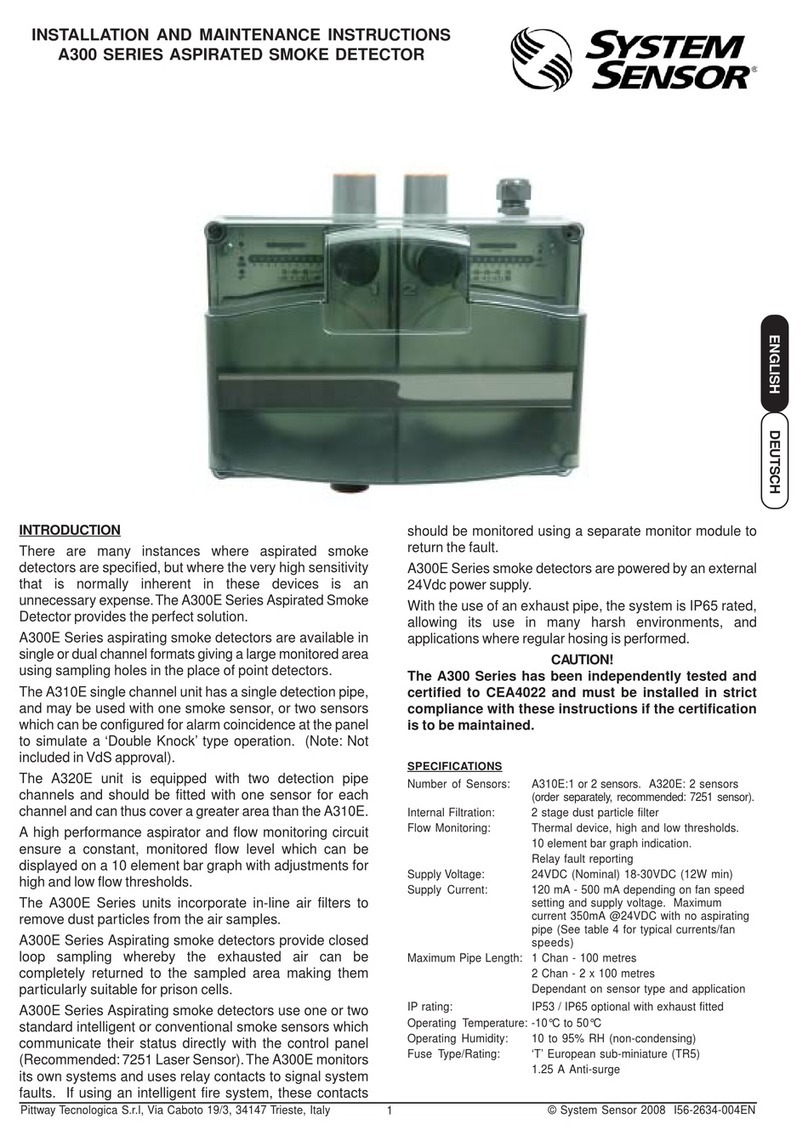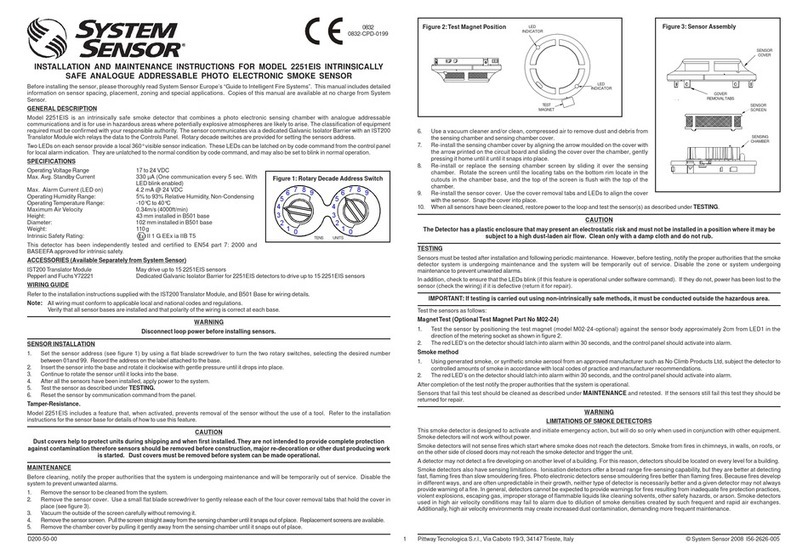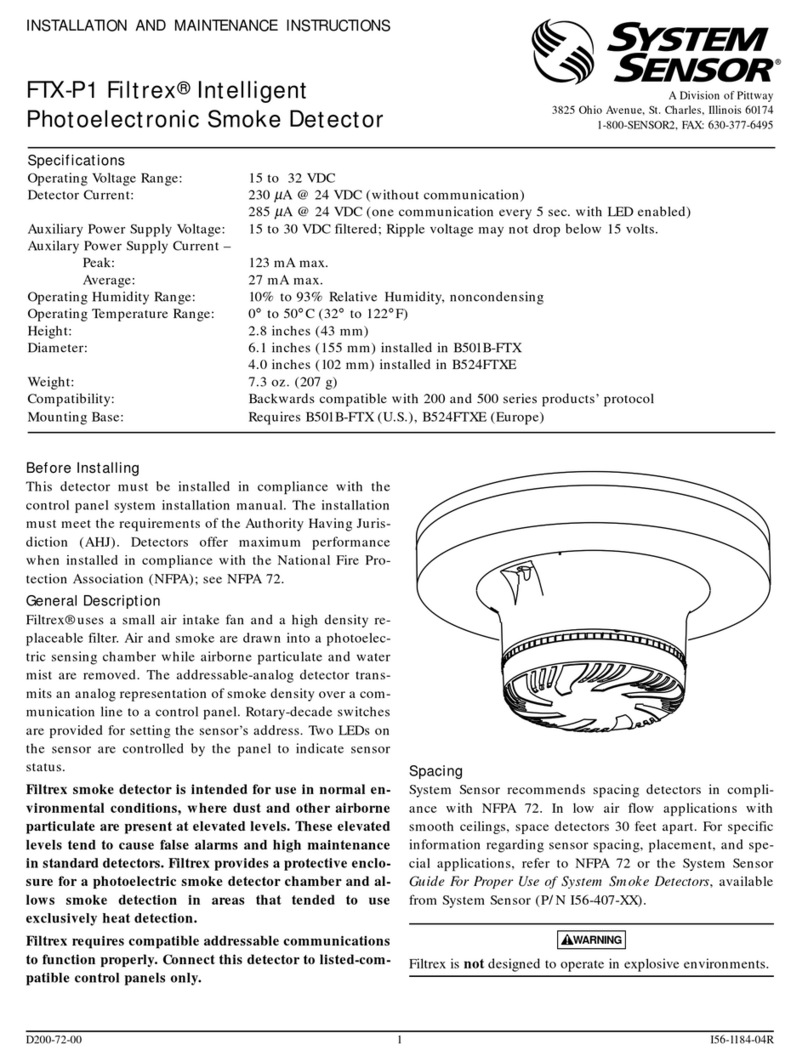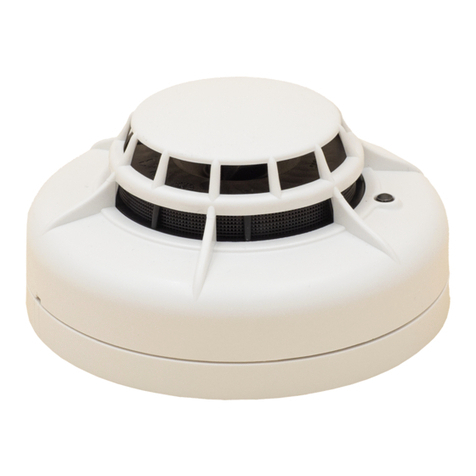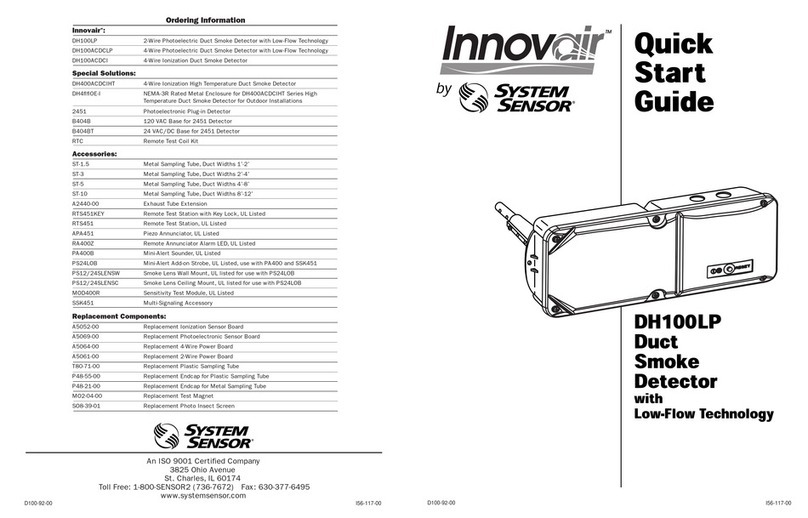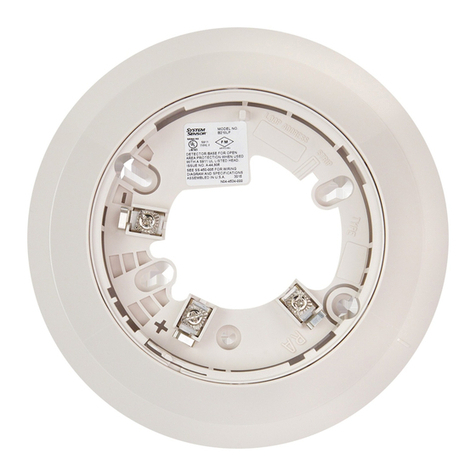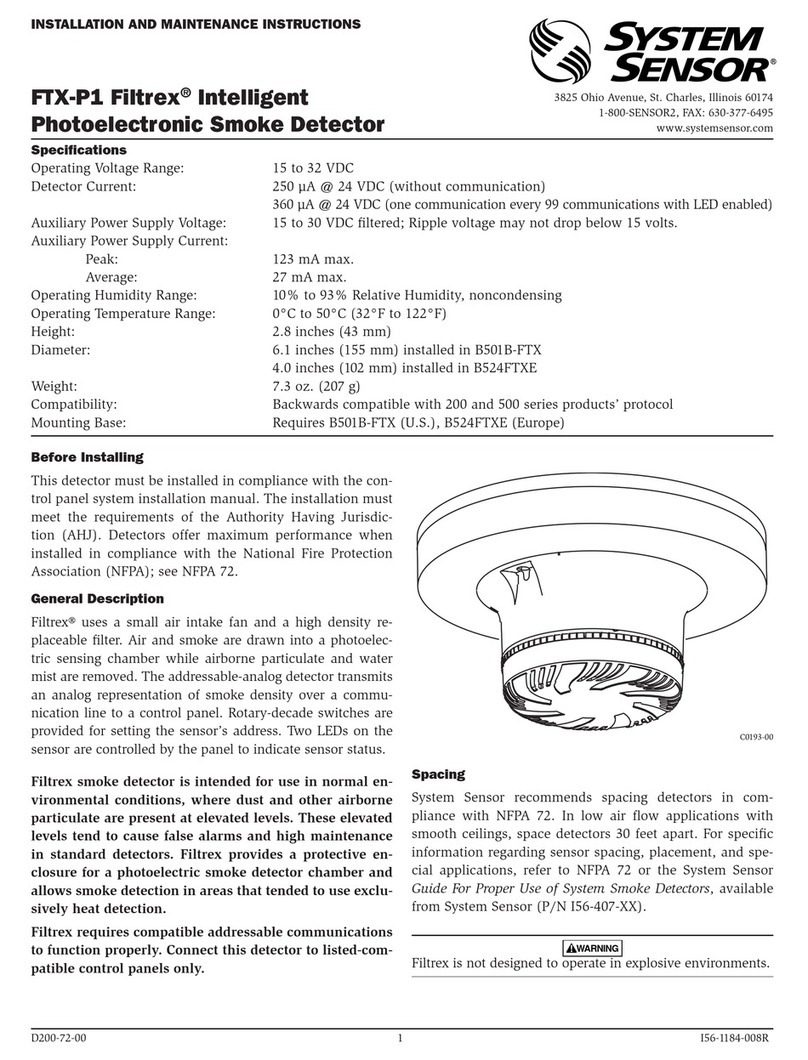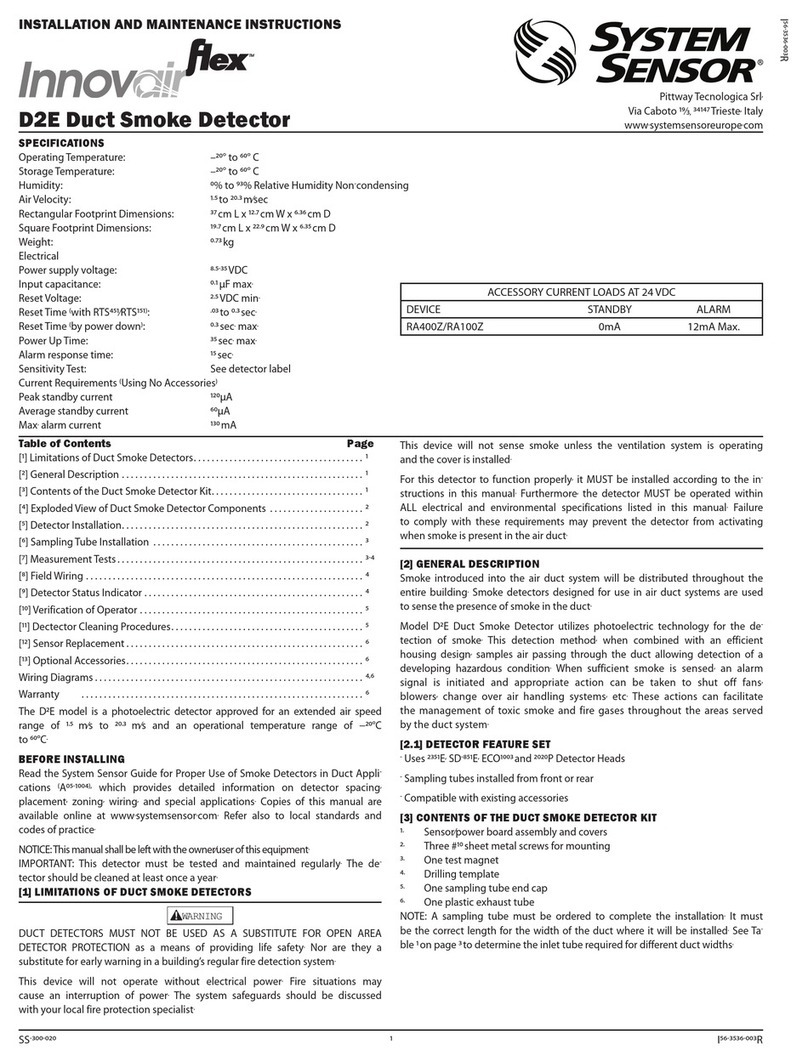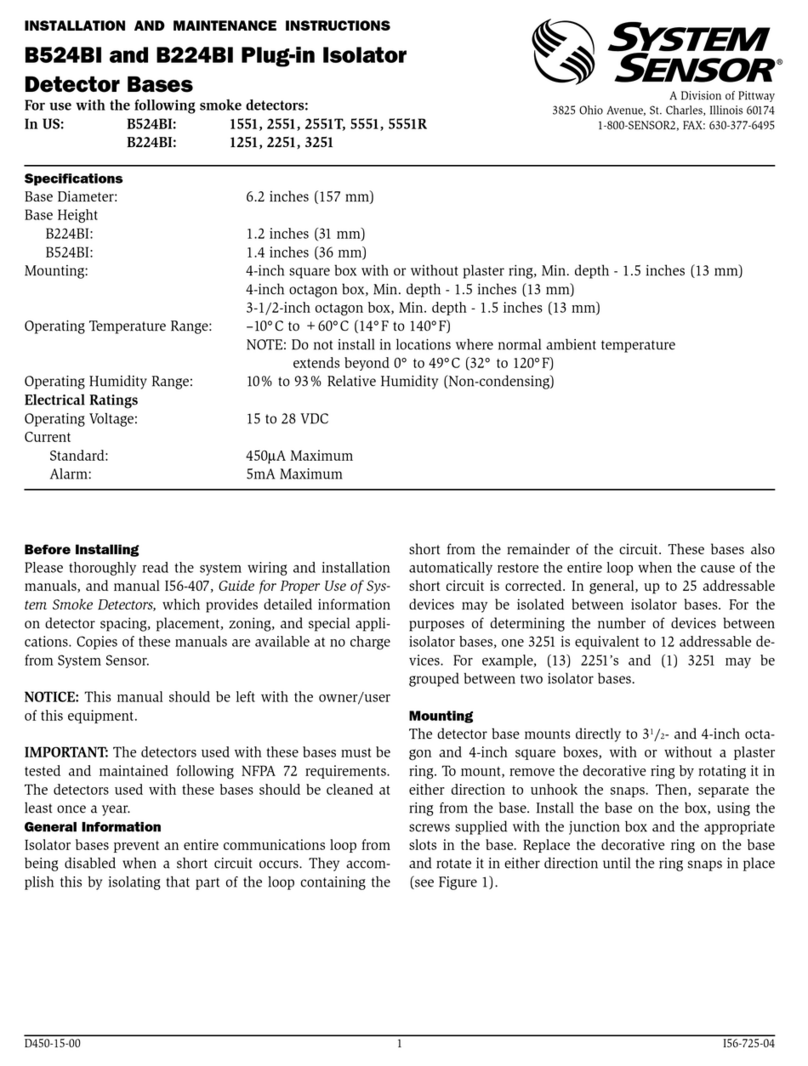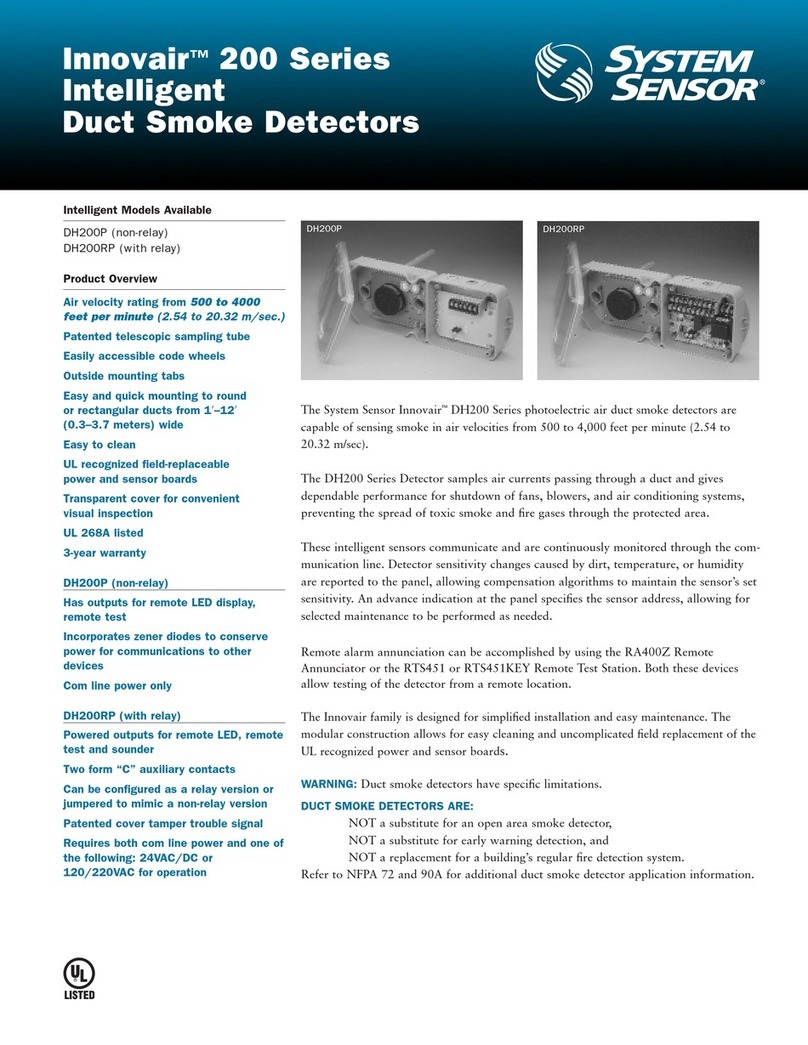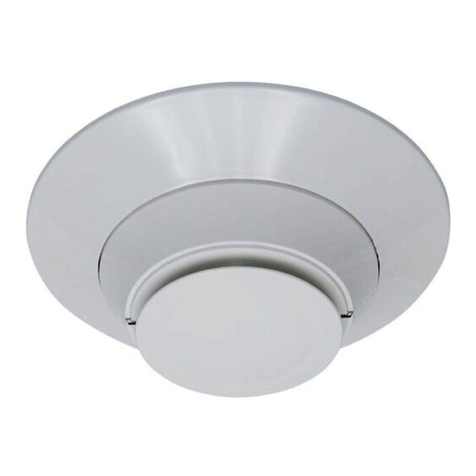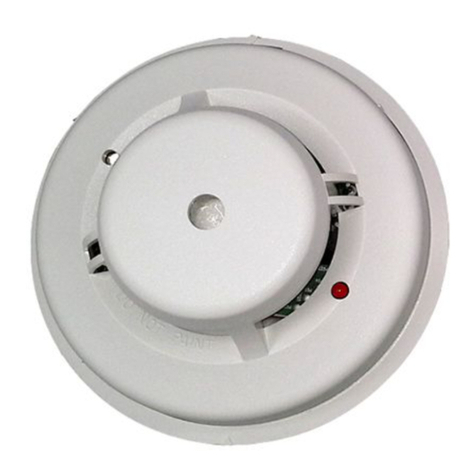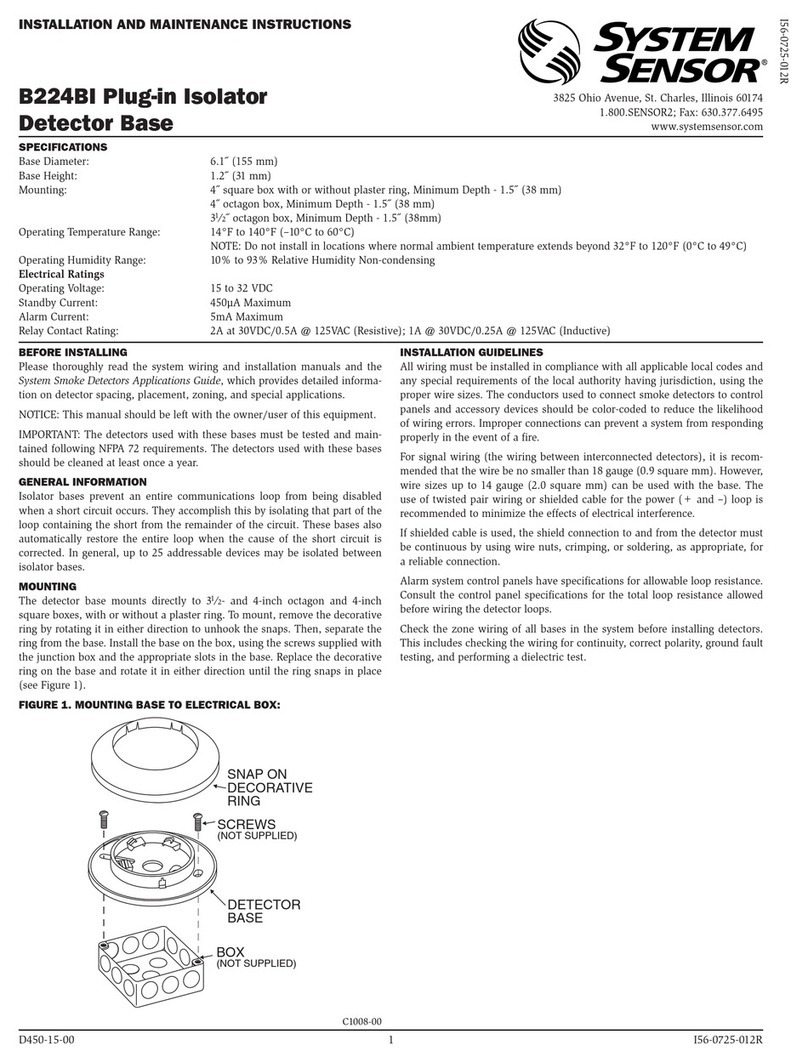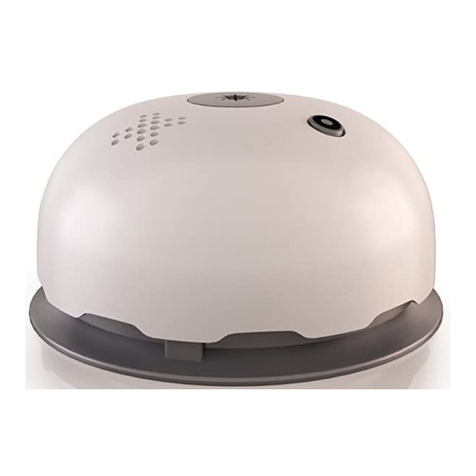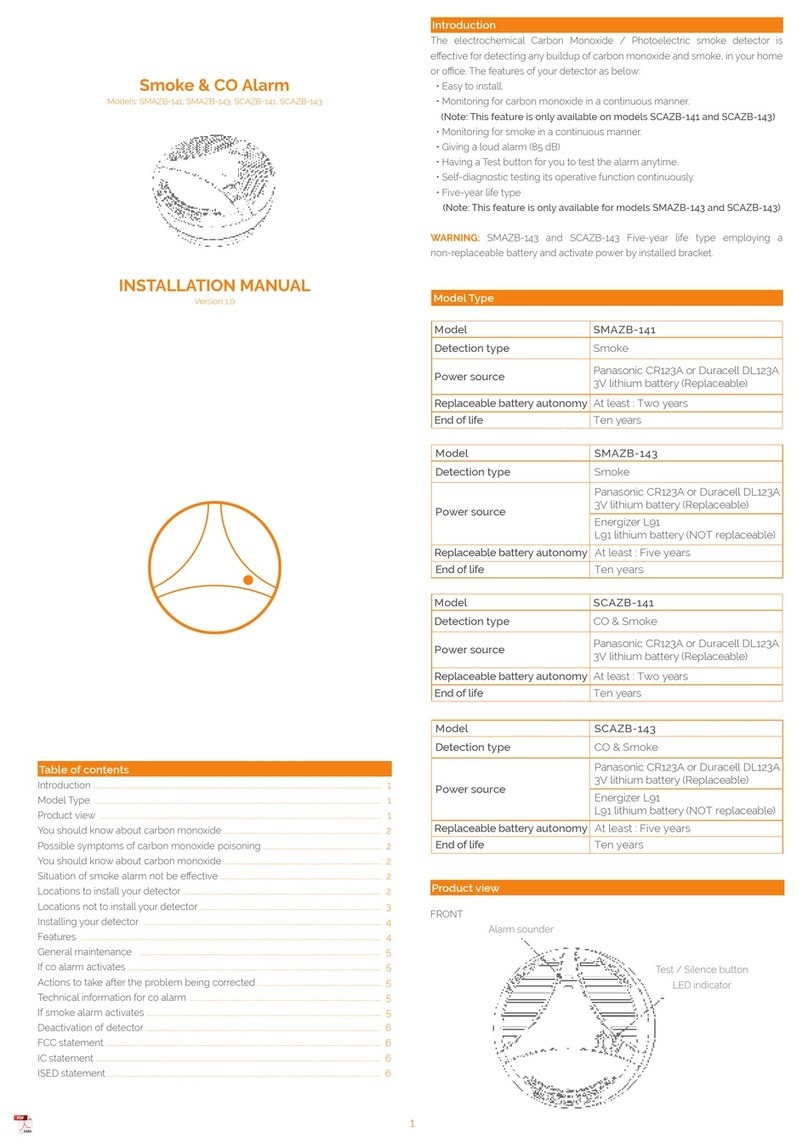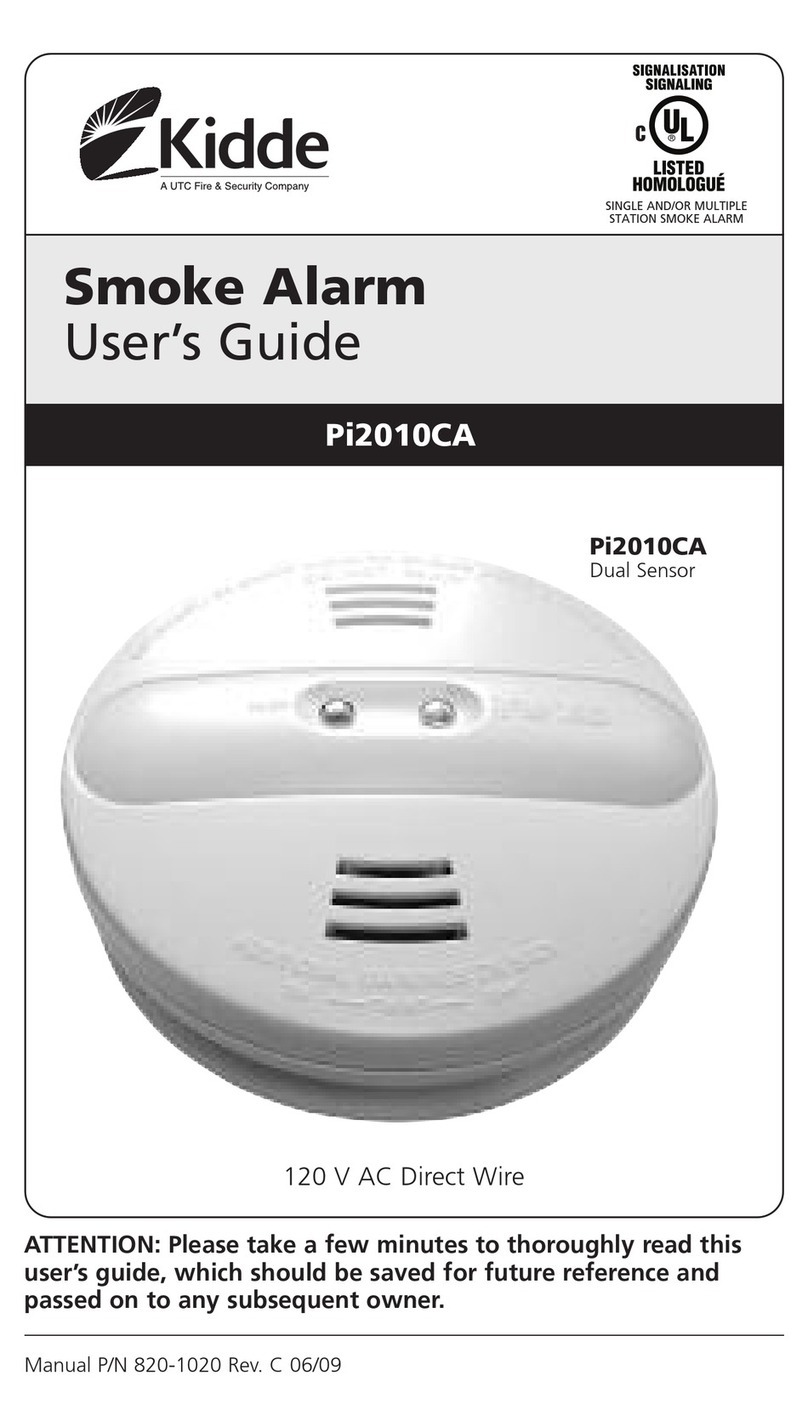2012JA Photoelectric Smoke Alarm
with ,QWHJUDO7HPSRUDOTone Sounder
INSTALLATION AND MAINTENANCE INSTRUCTIONS
Smoke Alarm Description
Smoke Alarm Power Requirements
supply and smoke-alarm installation must conform to the electrical codes
in your area and CAN/ULC S553. It is recommended that wiring be performed
by a licensed electrician.
Smoke alarm Limitations
This smoke alarm is designed for residential use only. This smoke•
alarm is self-restoring and does not lock into an alarm condition.
Smoke alarms will not sense a re if the smoke does not reach •
the sensor. In order for a smoke alarm to sense smoke, it must be
installed in the immediate vicinity of the re. In addition, smoke from
res in chimneys, in walls, on roofs, in remote parts of the building,
or on another level from where the smoke alarm is located, may
not reach the smoke alarm quickly enough for occupants to escape
unharmed. For this reason, the installer shall install smoke alarms
on every level, in every sleeping area, and in every bedroom of the
household.
Smoke alarms may not be heard. The alarm horn in this smoke•
alarm meets or exceeds current Underwriter's Laboratories
standards. However, if the smoke alarm is not located in the
same room as the occupant, or if it is blocked by a closed door
or normal noise, the alarm horn may not be heard. In addition,
sound sleepers, or persons who are under the inuence of drugs or
alcohol may not hear the alarm or be able to react to it. Therefore,
locate this smoke alarm, which has a sounder rated at 85dBA
at 3 meters, on every level, in every sleeping area, and in every
bedroom of the household.
In general, smoke alarms may not always warn you about res •
caused by carelessness and safety hazards like smoking in bed,
violent explosions, escaping gas, improper storage of ammable
materials, overloaded electrical circuits, children playing with
matches, or arson.
Smoke alarms are not fool-proof. Like all electronic devices,•
smoke-alarms have limitations. No type of smoke-alarm can
sense every kind of re every time. In addition, smoke from slow,
smoldering res rises slowly and may not reach the smoke alarm
until actual ame breaks out. This type of smoke may not reach the
smoke alarm in time for occupants to escape unharmed. Smoke
alarms are not a substitute for life or property insurance. Though
smoke alarms have been responsible for saving many lives, they
are not warranted or implied to protect lives or property in the
event of a re.
To keep your equipment in excellent working order, ongoing•
maintenance is required per the manufacturer’s recommendations
and ULC, a preventative maintenance agreement should be
arranged through the local manufacturer’s representative.Though
smoke alarms are designed for long life, they may fail at any time.
Therefore, smoke alarms shall be replaced after being in service
for 10 years. Any smoke alarm, re alarm equipment, or any
component of that system which fails shall be repaired or replaced
as soon as possible.
Where to Install Smoke Alarms
Warning: As a minimum requirement, smoke alarms must be installed in
accordance with CAN/ULC-S553. In addition, observe all local and national
building and electrical codes.
Proper Smoke Alarm Location:
Figure 1: Recommended smoke alarm protection for single-oor
residence with only one sleeping area
DINING ROOM KITCHEN BEDROOM BEDROOM
BEDROOMLIVING ROOM
SMOKE ALARMS FOR MINIMUM PROTECTION
SMOKE ALARMS FOR MORE PROTECTION AND
REQUIRED IN NEW CONSTRUCTION
6581 Kitimat Rd., Unit #6, Mississauga, Ontario, L5N 3T5
1-800-SENSOR2, FAX: 905-812-0771
www.systemsensor.ca
Specifications:
Supply Voltage Range: 10VDC~30VDC
Max. Standby Current: 60µA
Max. Alarm Current: 65mA
P-Horn Sound Output Level: 85dBA at 3m
Max. Interconnected Units: 12
Silence Timeout Period: 8 minutes
Silence Mode Indication: Sounder Beeps and LED Flashes Green once every 40 secs.
Height: 55mm
Diameter: 135mm
Weight: 180g
Operating Temperature Range 0° to 50°
Humidity: 5% to 93% R.H.
1 I56-2012-4 I56-2012-
Connecting Auxiliary Devices with Relay
This smoke-alarm has a built-in relay which may be used to activate
auxiliary devices such as bells, horns, and door closers. The relay contacts
automatically close approximately eight (8) seconds after the unit goes
into alarm, and automatically resets approximately ve (5) seconds after
the alarm stops. For wiring refer to Figure 8. Auxiliary voltage and current
requirements must be within relay contact ratings and appropriate wiring
must be used.
How to Interconnect Smoke Alarms
NOTE: Interconnect smoke alarms within one household only. If smoke
alarms are interconnected between households, nuisance alarms
will occur when a smoke alarm in another residence is tested.
The model 2012JA has two interconnection modes shown in
table 1.
TABLE 1: INTERCONNECTION MODES
Interconnection
Mode
Interconnected
Terminals
Electronic
Horn
Relay
SIGSND SIGSND and
GND
Sound Only the
smoke alarms in
local alarm are
activated
SIGRLY SIGRLY and
GND
Sound All the
interconnected
smoke alarms
are activated
Up to twelve 2012JA smoke-alarms may be interconnected. The•
2012JA smoke-alarms may also be interconnected with 2012H
(A) when they all work at 12VDC supply voltage by using SIGRLY
interconnecting terminal. If one smoke alarm senses smoke, all of
the interconnected units will sound in SIGSND mode, the relays
of the interconnected units will be activated approximately eight
seconds after horns sound in SIGRLY mode. After interconnecting
the smoke alarms, push and hold the test button for more than 3
seconds on one unit. The alarm horns on all of the other smoke
alarms should sound if they are connected correctly.
If any interconnected smoke alarm is activated by another unit, it•
senses smoke, the unit will go into local alarm state with the LED
ashing quickly.
Connect the smoke alarms together by interconnecting all the•
SIGSND terminals to each other and all GND terminals to each
other in SIGSND mode, interconnecting all the SIGRLY and GND
terminals to each other in SIGRLY mode. (See Figure 7.) Use 22
guage (#22AWG) or larger two-conductor standard wire.
If smoke alarms will not be connected, DO NOT use the SIGSND,•
SIGRLYand GND terminals.
The LEDs on all smoke alarms should ash once about 40 seconds •
when power is turned on to the units.Test smoke alarms after
interconnection wiring are complete.
Cautionary Note: Test interconnection wiring after installation is
completed. Test each unit in a system and make sure
all other units alarm. FAILURE TO OBSERVE ANY
OF THESE CONDITIONS CAN CAUSE SYSTEM
MALFUNCTION AND/OR DAMAGE TO THE ALARMS.
Testing Information
You should test your smoke alarm at least once a week to assure•
yourself of its operation, as recommended by ULC. Test the smoke
alarm by rmly depressing the test switch located on the smoke
alarm cover (marked “Push and Hold to Test”) FOR MORE THAN 3
SECONDS (See Figure 9). The alarm horn should sound, and the
LED should ash rapidly. When the test switch is pushed and held
for more than 8 seconds, the relay will be activated.
In an interconnected system, all of the smoke alarms should sound•
their alarm horns when any one of the test buttons is pushed and
held for more than 3 seconds. The alarm horn sounds if the smoke
alarm is working properly. This is the only way to be sure the
smoke alarm is working. Test the smoke alarm weekly. If the
smoke alarm fails to test properly, have it repaired or replaced
immediately.
DANGER: If the alarm horn sounds an alarm and you are not•
testing the smoke alarm, the unit has sensed smoke or
combustion particles in the air. THE ALARM HORN IS AWARNING
OF APOSSIBLY SERIOUS SITUATION. IT REQUIRES YOUR
IMMEDIATE ATTENTION.
The alarm could be caused by a nuisance situation. Cooking smoke•
or a dusty furnace can cause the smoke-alarm to sound. If this
happens, open a window or fan the air to remove the smoke or
dust. The smoke alarm will turn itself off as soon as the air is
completely clear. DO NOT TURN OFF POWER TO THE SMOKE
ALARM. THIS WILL REMOVE YOUR PROTECTION.
Monitoring Your Smoke Alarm
Once the smoke alarm is powered, a green LED ashes once about 40
seconds. This signals that the smoke alarm is receiving power and is in
the detection mode. If the smoke alarm is not operating properly, the
green LED will be OFF. (If so, have the smoke alarm repaired or replaced
immediately.) When the smoke alarm senses smoke, the green LED will
ash rapidly. If the initiating smoke alarm senses smoke and signals other
interconnected smoke alarms to sound their alarm horns, their LEDs will
stop ashing. See TABLE 2 for specic LED functions.
TABLE 2: SMOKE ALARM STATUS
Smoke alarm
Status
Electronic
Horn
LED Relay
Normal
Standby
Silent Flash every
40 seconds
Open
Silence State Beep every 40
seconds
Flash every
40 seconds
Open
Local Alarm Temporal Tone Flash rapidly Closed after
8 seconds
SIGSND
Signal
Received
Temporal Tone Off Open
SIGRLY Signal
Received
Temporal Tone Off Closed after
8 seconds
Failed cham-
ber test
Beep every 40
seconds
Flash every
10 seconds
Open
The smoke alarm will automatically return from Alarm to Normal state
when the reason for alarm, as the presence of smoke, is completely
removed.
As the re is very dangerous for your family, usually you must draw a
family escape plan including a map which shows all your home windows
and doors, less than two escape routs, a safe meeting place and other
required things in your area.
Furthermore your family members should practice the escape plan at
least twice a year.
Cleaning and Maintenance
DANGER: Electrical Shock Hazard. Turn off power to the smoke alarm at
the main service panel before cleaning the smoke alarm.
This smoke alarm has been designed to be as maintenance-free as
possible. However, regular testing (see “Testing” above) and periodic
maintenance are necessary.
To clean the smoke alarm, turn off power and vacuum the outside of the
smoke alarm with the soft brush attachment of a vacuum cleaner. Do this
at least once every year, preferably every six months. DO NOT ATTEMPT
TO CLEAN THE SMOKE ALARM IN ANY OTHER WAY.
If the smoke alarm requires service, do not attempt to service it yourself ;
this will void your warranty. Return the smoke alarm to your local System
Sensor distributor or agent. Enclose a note describing what is wrong
with the smoke alarm.
Special Note Regarding Smoke Alarm Guards
Smoke alarms are not to be used with alarm guards unless the combination
has been evaluated and found suitable for that purpose.
Please refer to insert for the Limitations of Fire Alarm Systems
PUSH TO SILENCE
PUSH AND HOLD TO TEST LED
SILENCE/TEST
SWITCH
Figure 9:
Smoke alarms are designed to provide early warning of developing fires at a
reasonable cost. They monitor the air and can sense smoke, providing
precious minutes for you and your family to escape before a fire spreads.
Early warning fire detection is best achieved by the installation of fire
detection equipment in all rooms and areas of the household.
Model 2012JA is a photoelectric smoke alarm designed for open area
protection in a residential building. It has a built-in relay which may be used to
activate auxiliary devices such as bells, horns, and door closers. The relay
contacts automatically close 8 seconds after the unit goes into alarm, and
automatically resets approximately 5 seconds after the alarm stops. A
piezoelectric horn in each smoke alarm produces an audible 85dBA temporal
tone evacuation signal when the unit alarms or an interconnected one alarms.
This temporal tone evacuation signal complies with CAN/ULC-S531-02.
The signal consists of 3 beeps each 0.5 seconds long. spaced 0.5 seconds
apart, followed by 1.5 seconds of silence. These smoke alarms can be
interconnected with the SIGSND and GND terminals for a system of up to 12
units per premises so when one smoke alarm sounds its evacuation signal it
causes the other connected smoke alarms to sound as well. They also can be
interconnected with the SIGRLY and GND terminals, when any one alarms,
all the interconnected units’ relays will be activated approximately 8 seconds
after their horns sound. The smoke alarm has a built-in silence/test push
button to silence or test. If the silence/test button is pushed for less than 3
seconds, this is a silence instruction, the smoke alarm will reduce its
sensitivity and give an audible trouble signal for about 8 minutes. If the
silence/test button is pushed and held for more than 3 seconds, this is a test
instruction (See “Testing” below for more detailed instructions.).
NOTE: If the smoke alarm is not in alarm but beeps and flashes every 40
seconds, it is in the silence state. To exit this silence state when the unit
is not in alarm, press and hold the silence/test button for more than 3
seconds to do a test.
Ver.$
